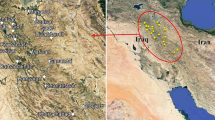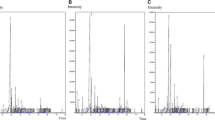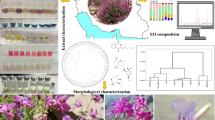Abstract
In 2006, 26 accessions (mainly from Sichuan province, China) in one species and two varietal species among the genus Perilla L. were collected, and the essential oils (EOs) of their fresh leaves during the flowering period were analyzed by the GC-MS method in 2007. In total, 49 components could be identified. The results showed that eight chemotypes could be identified as follows: PK (perillaketone), DLP (d-limonene and piperitone), PT (piperitenone), MS (myristicin), AL (apiol), EM (elemicin), DEK (dehydroelsholtzia ketone) and PA (perilla aldehyde). Of them, chemotype DLP, AL and DEK were reported for the first time; DLP and AL were found only in the accessions from Sichuan province, China. In our study, the EOs of P06-1Z and P06-28 were investigated at several stages during growing. Taking into account the variability of the two accessions during the year, the seasonal influence on the main constituents could not change the status of the different chemotypes distinguished or enhance the veracity of the differentiation of eight chemotypes. The results also suggested that it may not always be possible to establish a correlation between the traditional morphological taxonomy and chemotypes.
Similar content being viewed by others
Avoid common mistakes on your manuscript.
Introduction
Perilla L. comprises self-fertilizing annual species that are widely distributed in East Asian regions such as China, Korea and Japan (Li 1974; Lee et al. 2002). Nitta et al. (2005) reported that the genus Perilla was composed of one cultivated species, P. frutescens (L.) Britt., and three wild species, P. citriodora (Makino) Nakai, P. hirtella Nakai and P. setoyensis G. Honda, and that all three wild species are distributed in China, mainly along the Changjiang (Yangtze) River. According to the Flora Reipublicae Popularis Sinicae, one species and two varietal species are in the genus Perilla; they are characterized on the basis of their morphology and dual uses, including P. frutescens (L.) Britton var. frutescens (including zisu and baisu), P. frutescens var. purpurascens (Hayata) H. W. Li and P. frutescens var. crispa (Benth.) Deane ex Bailey (Li 1974; Liu et al. 1996). P. frutescens var. frutescens (zisu) generally has purple leaves and stems, while P. frutescens var. frutescens (baisu) has green ones. P. frutescens var. crispa is characterized by the unique wrinkled leaves and is mainly distributed in Sichuan and Guizhou provinces, China. P. frutescens var. purpurascens always has a shorter plant height and smaller seed size than any other (varietal) species (Li 1974; Liu et al. 1996).
Perilla accessions are widely used for flavoring, food, medicine and oil in China, Korea and Japan (Li 1974; Lee et al. 2002). Perilla frutescens var. frutescens has traditionally been credited with a long list of medicinal uses because of its biologically active compounds, including for the treatment of influenza, cough, vomiting and chronic bronchitis (Zheng et al. 1997; Chen et al. 2004). It was reported that P. frutescens (zisu) was also used as a spicy vegetable crop and P. frutescens (baisu) as an oil crop (Natta and Ohnishi 1999). Perilla frutescens var. frutescens has been identified as one of the medical and edible plant genetic resources with the most potential by the Chinese State Health Department. Actually, all the accessions are used as medicine by Chinese people (Yu and Wang 2006).
Previous analysis reported that the genus Perilla has a characteristic odor because of the variety of essential oil components that affects their nutritional and medical functioning and toxicity (Ito et al. 1999a, b, 2002). Perilla EO is known for its high variability, and many chemotypes from different accessions have been investigated. For example, Ito et al. (1999a, b, 2002) presumed and classified Perilla plants into the following seven chemotypes: PA-type containing perilladehyde, EK-type containing elsholtziaketone, shisofuran, and/or naginataketone, PK-type containing perillaketone and/or isoegomaketone, PL-type containing perillene, C-type containing citral, PP-type containing myristicin, dillapiole and/or elemicin, and PT-type containing piperitenone. P. frutescens var. frutescens in northern Laos was divided into five chemotypes, namely perillaketone, elemicine plus myristicine, shisofuran, piperitenon and myristicine (Ito et al. 2007). The Indian accession is rich in rosefuran (Misra and Husain 1987). Limited by the materials, only the chemotypes PA, PP and PT were reported in China (Zhao et al. 1993; Zeng and Zhou 2003; Wu et al. 2003). Unfortunately, there were no reports on the Perilla EO variations in the Sichuan province of China, where the genus Perilla is widely distributed. No published investigations on the correlations between the chemotypes and morphological taxonomy and geographic distribution were found.
The aim of this study was (1) to characterize the EO variations of one species and two varietal species among genus Perilla (mainly from Sichuan province, China) to check whether there are specific Perilla chemotypes in Sichuan province, China; (2) to identify correlated relationships between the traditional morphological taxonomy and chemotypes; (3) to analyze the impact of seasonal variations on the compositions of the essential oils of Perilla accessions to identify the curative potential of the chemotypes.
Experimental
Plant material
In April 2006, 26 different accessions of Perilla L. were collected, including six from the America National Germplasm Resources Laboratory, 16 from Sichuan province, two from Guangdong province and 1 from Chongqing province, China. They were planted in the orchard of Sichuan Agricultural University at Ya’an in Sichuan province, China. All the plants identified as Perilla L. were confirmed by Prof. GuanghuiYang, Sichuan Agricultural University, China. The Latin names, accessions numbers, localities and habitats of the experimental accessions are presented in Table 1. Voucher specimen for each material are deposited in Sichuan Agricultural University, China.
In April 2007, all 26 different accessions of Perilla L. were planted for the second time. Samples of the fresh leaves of all 26 Perilla L. accessions were taken during the flowering period, and P06-1z and P06-28 were sampled at six growing stages, every 20 days from 25 June to 5 October.
Essential oil extraction
Fifty grams of fresh leaves were sampled and weighed. The EOs were obtained by hydrodistillation in 500 ml H2O for 4 h (State Pharmacopeia Committee of the People’s Republic of China, 2005); 2 ml ethyl acetate was used as solvent. The ethyl acetate layers were collected to the constant volume of 10 ml using ethyl acetate. The extracts were sealed with parafilm and stored at 4°C refrigeration until GC–MS analysis.
Gas chromatography-mass spectrometry
GC-MS analyses were performed on an Agilent 5973 MS system coupled with an Agilent 6890 gas chromatograph, equipped with a HP-5MS capillary column (30 m × 0.25 mm, film thickness 0.25 μm). Operating conditions were as follows: carrier gas, helium at a flow rate of 1 ml/min; injector temperature was 250°C; injection volume of each sample was 1 μl; split ratio was 1:50; the GC temperature program was 70–150°C at a rate of 5°C/min and held at 150°C for 2 min, then from 150°C to 220°C at a rate of 10°C/min; interface temperature was 280°C. The MS was operated in EI mode (70 eV). The EO constituents were identified by the use of a combination of mass spectrum database search (NIST 2.0 Database), relative retention indices and comparison of mass spectra from the published data.
Data analysis
Cluster analysis (CA) was used to establish the different groups/chemotypes within individual essential oils. Dendrograms were generated by using the unweighted pair-group method with the arithmetic average (UPGMA) method with the Euclidean distance (ED) matrix based on the volatile composition percentages. All data analysis was completed with DPSv 6.05 Software.
Results and discussion
The results in Table 2 show that 49 chemical components could be identified from the essential oil (EO) of the fresh leaves of Perilla accessions, accounting for 99.03% of the whole volatiles of the leaves. Among 49 components identified, only 3-hexen-1-ol and β-caryophyllene were found in all the accessions, but they were not the major quantitative compounds of any accessions. A high level of chemical polymorphism in the EOs of the fresh leaves of Perilla L. accessions was observed in this investigation.
The examined EOs revealed marked differences in qualitative and quantitative compounds. Only on the basis of the main compounds in the GC–MS data could eight chemotypes (Fig. 1) be described within the investigated Perilla accessions by using cluster analysis (Fig. 2). They are chemotype PK (perillaketone), DLP (d-limonene and piperitone), PT (piperitenone), MS (myristicin), AL (apiol), EM (elemicin), DEK (dehydroelsholtzia ketone) and/or PA (perilla aldehyde). Ito et al. (1999a, b, 2002) presumed the biosynthetic pathways of each component and classified all the phenylpropanoids as one type (PP type). Thus, the three phenylpropanoids types, MS, AL and EM, could also be described as PP-type.
The total iron chromatographs (TIC) of the eight chemotypes of Perilla L. accessions essential oils. a The TIC of EO of chemotype DLP. b The TIC of EO of chemotype EM. c The TIC of EO of chemotype MS. d The TIC of EO of chemotype DEK. e The TIC of EO of chemotype PT. f The TIC of EO of chemotype PK. g The TIC of EO of chemotype AL. h The TIC of EO of chemotype PA
Compared with the published literature, our results showed some differences (Ito et al. 1999a, b, 2002; Ito et al. 2007; Misra et al. 1987). For example, no C-type containing citral reported by Honda et al. (1994) was detected in this study. The chemotype PL was also not determined in our experiment; although perillene was found in some accessions (P06-10B and P06-11Z), it was not the main compound. The chemotype DLP in this study was a new type dominated both by d-limonene and piperitone (P06-6, P06-13), which were not the new compounds in the EOs of Perilla accessions and never found as the main compounds. The chemotype AL containing Apiol was detected for the first time (P06-11B, P06-17B). The chemotype DEK dominated by dehydroelsholtziaketone (P06-31) had some differences from the reported EK-type containing elsholtziaketone (Ito et al. 1999a; b; 2002; Ito 1999d). The flavor of the EKD type was unique, distinguishing P06-31 from the other accessions. It might be another new chemotype.
Some researchers put forward that China is the primary diversity center of genus Perilla (Makino 1961; Li 1969). The accessions of the genus Perilla are widely distributed in Sichuan province, China (Li 1974). In this study, the newly detected chemotypes AL and DLP are distributed only in Sichuan province, China. The other chemotypes, except for the chemotype EKD, all could be found in Sichuan province. As all the accessions were planted in the same growing plots with the same field management and all were harvested at the flowering stage, quantitative differences in the EO compositions might be due mainly to the genetic background. It is inferred that Sichuan province shows the primary diversity of genus Perilla.
The amounts and compositions of the EOs of P06-1z and P06-28 were investigated at six different growing stages, and the GC–MS data were listed with their percentage compositions (Tables 3 and 4), and the multiple comparisons of major volatile constituents (>5%), such as d-limonene, perilla aldehyde and perilla alcohol contents in P06-1z, β-caryophyllene and myristicin in P06-28 at different growth stages are also listed. Significant difference between the contents of the different major compounds during different growing stages were found, except for β-caryophyllene in P06-28. The contents of perillaldehyde showed a tendency to increase, while those of d-limonene and β-caryophyllene decreased while growing in EO of P06-1Z. Myristicin was the main compound of P06-28; it was relatively stable, only decreasing significantly on 15 July. Considering the variability of the two accessions during the year, the seasonal influence on the main constituents could not change the status of the different chemotypes distinguished, which could intensify the veracity of the differentiation of eight chemotypes.
The distribution of the main compounds and characterization of the essential oil from the four morphological groups are summarized in Table 5. It was interesting to note that in some case the same chemotype was obtained from different (varietal) species, for example, chemotype PA was detected both in the EOs of P. var. frutescens (including zisu and baisu) and P. var. crispa (Table 5). Meanwhile, one (varietal) species might contain different chemotypes, for example, the EOs of P. var. frutescens (baisu) were reported to include chemotype PK and PP by Zhao et al. (1993); the chemotypes PA and PT were also found in this study. According to the table, some new chemotypes were found in P. var. frutescens (baisu) and P. var. frutescens (zisu) accessions. No Perilla aldehyde was detected in P. var. frutescens (baisu) by Nitta et al. (2006). However, in our study, two accessions were chemotype PA. Except for chemotype PA and PP reported by Zhao et al. (1993), chemotype DEK was also determined in P. var. frutescens (zisu) accessions.
Ito et al. (1999a, b, 2002) reported that the essential oil components that were secondary metabolites were produced under genetic regulation either from mevalonic acid as isopentenyl diphosphate (IPP) derivatives or from shikimic acid as phenylpropanoids (PPs). The results indicated that the two basic biosynthetic pathways co-existed in each species and/or varietal species in our study. Thus, chemical variations of essential oils may be promising, having chemotaxonomic importance for the whole genus, but to what extent the composition of the essential oils reflects taxonomic or phylogenetic relationships in the genus Perilla accessions is unknown at present. The results also suggested that it was not always possible to establish a strictly correlated relationship between the traditional morphological taxonomy and chemotype. The taxonomic position of the EO needs to be clarified in future studies.
The EO components are the main compounds affecting the medicinal functionality and toxicity of plants from the genus Perilla (Yu and Wang 2006). Different components have different functions. Perillaketone was reported be a potent lung toxin (Wilson et al. 1997). Perilla resources are all traditionally used as Chinese medicines and vegetables in China (Yu and Wang 2006). The use of Perilla resources in oriental foods and medicinal preparations infers possible hazards to human health as well. Thus, not all the Perilla accessions can be selected to be used as Chinese medicine or food plants just on the basis of botanical taxonomy. The scientific evaluation of Perilla accessions is needed.
Abbreviations
- EO:
-
Essential oil
- GC–MS:
-
Gas chromatography–mass spectrometry
- PK:
-
Perillaketone
- DLP:
-
d-Limonene and/or piperitone
- PT:
-
Piperitenone
- MS:
-
Myristicin
- AL:
-
Apiol
- EM:
-
Elemicin
- DEK:
-
Dehydroelsholtzia ketone
- PA:
-
Perilla aldehyde
- UPGMA:
-
Unweighted pair-group method with arithmetic average
- ED:
-
Euclidean distance
- TIC:
-
Total iron chromatographs
References
Chen GG, Zhang JY, Guo YL (2004) Analysis of volatile components of fresh Perilla frutescens (L.) Britt. var. acuta (Thunb.) Kudo by headspace GC/MS. J Essent Oil Res 16:435–436
Honda G, Yuba A, Nishizawa A, Tabata M (1994) Genetic control of geranial formation in Perilla frutescens. Biochem Genet 32(5–6):155–159
Ito M, Toyoda M, Honda G (1999a) Chemical composition of essential oil of Perilla frutescens. Nat Med 53:32–36
Ito M, Toyoda M, Honda G (1999b) Essential oil composition of hybrids and amphidiploids of Japanese wild Perilla. Nat Med 53:118–122
Ito M, Toyoda M, Yuba A, Honda G (1999c) Genetic analysis of Northoapiol formation in Perilla frutescens. Biol Pharm Bull 22:598–601
Ito M, Kiuchi F, Yang LL, Honda G (2002) A new type of essential oil from Perilla frutescens from Thailand. J Essent Oil Res 14:416–419
Ito M, Honda G, Sydara K (2007) Perilla frutescens var. frutescens in northern Laos. Nat Med 10:29–36
Lee JK, Nitta M et al (2002) Genetic diversity of Perilla and related weedy types in Korea determined by AFLP analyses. Crop Sci 42(6):2161–2166
Li HL (1969) The vegetable of ancient China. Econ Bot 23:235–260
Li XW (1974) Flora Reipublicae Popularis Sinicae, vol 65. Science, Beijing, pp 282–287
Liu YX, Zhang WM, Qian XS (1996) Invistigation an utilizing of Perilla. Wilding Resour China 3:24–27
Makino T (1961) Makino new illustrated flora of Japan. Hokuryukan Publishing, Tokyo
Misra L, Husain A (1987) The essential oil of Perilla ocimoides: a rich source of rosefuran. Planta Med 53:379–380
Natta M, Ohnishi O (1999) Genetic relationships among two Perilla crops. Shiso and cgoma, and weedy type revealed by RAPD marks. Genes Genet 74:43–48
Natta M, Lee JK et al (2005) The distribution of Perilla species. Genet Resour Crop Evol 52:797–840
Nitta M, Kobayashi H, Ohnishi-Kameyama M, Nagamine T, Yoshida M (2006) Essential oil variation of cultivated and wild Perilla analyzed by GC/MS. Biochem Syst Ecol 34:25–37
Wilson BJ, Garst JE, Linnabary RD, Channell RB (1997) Perilla ketone: a potent lung toxin from the mint plant, Perilla frutescens Btitt. Science Magazine 5:573–574
Wu ZH, Wu CM, Xu Y (2003) Study on chemical composition of essential oil of Perilla leaves. Amino Acids & Biotic Resour 25(2):18–20
Yu Sl, Wang XL (2006) Nourishment value and comprehensive exploitation of Perilla for medicine. Food Sci Technol 8:287–290
Zeng HY, Zhou PH (2003) Studies on the volatile oils from the leaves of Perilla frutescens (L.) Btitt. J Chin Inst Food Sci Technol 3(2):72–76
Zhao SP, Zhu ZY, Feng YX et al (1993) Studyings on chemical components of essential oil of different chemical type from Perilla frutescens (L.) Btitt. var. argata. and P. frutescens. Nat Prod Res Dev 5(3):8–20
Zheng H, Dong Z, Se J (1997) Mordern study of traditional Chinese medicines,vol 5. Xue Yuan Press, China, pp 4354–4363
Acknowledgments
We are grateful to Prof. GuanghuiYang for the identification of the plant accessions and thank Mr. Erdong Guan for assistance with essential oil extraction.
Author information
Authors and Affiliations
Corresponding author
Rights and permissions
About this article
Cite this article
Zhang, X., Wu, W., Zheng, Y. et al. Essential oil variations in different Perilla L. accessions: chemotaxonomic implications. Plant Syst Evol 281, 1–10 (2009). https://doi.org/10.1007/s00606-009-0152-1
Received:
Accepted:
Published:
Issue Date:
DOI: https://doi.org/10.1007/s00606-009-0152-1






